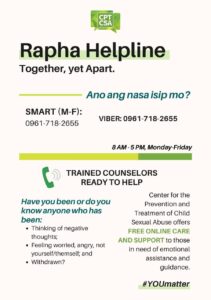Circumcision and child sexual abuse are not directly related. However, CPTCSA has an interest in how circumcision is conducted when it is done publicly during early pubescence for two reasons. First, because more young boys are sexually abused than girls in the Philippines, and second, because the penis plays an important part in sex and sexuality, and thus its abuse.
What all cultures appear to have in common, however, is that boys don’t really have a choice. As infants, the choice is with their parents. As teens, the choice is based on rationale stated as fact that limit real ability at consent. For example, the most common rationales for male circumcision include religion, hygiene, relationship to sexuality, and culture/tradition.
Over the next posts, we will look at why parents choose circumcision for their sons and why culture imposes this on their teenage boys. But first, let’s talk about consent, because ultimately whether you are circumcised or not is not the issue; the issue is whether you gave consent.
Let’s look closely at what consent is. The dictionary has a simple definition, “permission for something to happen or agreement to do something”. Consent implies that you have full information about what you are consenting to. What does that mean for whether you consented to be circumcised?
- Consent is freely given. There is no pressure or manipulation, including bullying or other criticism for the choice.
- It is reversible. Someone should be able to change their minds at any time. Even if they said yes early on, they could say no after that, even if they are on the table for the procedure, they can still say no.
- Consent is wanting to do it. It is doing only those things that someone feels comfortable doing. They should not be expected to do things they don’t want to do.
- Consent is specific. If someone says yes to circumcision, this does not mean they are saying yes to how the circumcision is being done.
- It is informed. Someone cannot actively and freely agree if they don’t have the full information.
Keep these conditions of consent in mind over the next blogs as we discuss the various rationale given for boys to be circumcised to help towards “full information”.
To begin, let’s understand who our male readers are by completing the anonymous survey. As you complete the survey, ask yourself, “Did I consent to this?”




 Each child’s survival story will be different depending on their age, gender, family, experience, and many other factors in their environment.
Each child’s survival story will be different depending on their age, gender, family, experience, and many other factors in their environment. This is an online game which can be played by a family with easily obtainable materials to help families recognize and talk about how they are adjusting to the new normal.
This is an online game which can be played by a family with easily obtainable materials to help families recognize and talk about how they are adjusting to the new normal. Patakarang pangkaligtasan para sa proteksiyon laban sa pang aabusong sekswal, ito ang tinatawag na Mga PATAKARAN SA PAGHAWAK
Patakarang pangkaligtasan para sa proteksiyon laban sa pang aabusong sekswal, ito ang tinatawag na Mga PATAKARAN SA PAGHAWAK This video introduces you to one form of prevention of sexual violence on children: Teaching personal safety to children/students, their teachers and their parents.
This video introduces you to one form of prevention of sexual violence on children: Teaching personal safety to children/students, their teachers and their parents. Mga magulang/ taga pag alaga, ang pag unawa sa ating mga damdamin at kung paano ang reaksiyon ng ating katawan dito ay mahalaga para sa ating kaligtasan.
Mga magulang/ taga pag alaga, ang pag unawa sa ating mga damdamin at kung paano ang reaksiyon ng ating katawan dito ay mahalaga para sa ating kaligtasan. Storytelling is an easy way to teach. CPTCSA has products to help families read to children to help them understand the concepts for personal safety and getting help. Click here to see and hear the story of Erika and Jay as they learn the touching rule. This book is also available on our website to purchase hard copies.
Storytelling is an easy way to teach. CPTCSA has products to help families read to children to help them understand the concepts for personal safety and getting help. Click here to see and hear the story of Erika and Jay as they learn the touching rule. This book is also available on our website to purchase hard copies. 